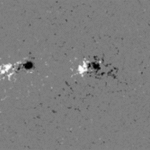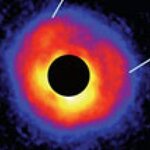Space

Scottish astronomers have found a baby planet still in the stages of forming and encased within a 'womb' of gas.
The embryonic planet, thought to be the youngest ever seen, was discovered by Dr Jane Greaves of the University of St Andrews and colleagues from across the UK and the US.
The finding provides a unique view of how planets take shape, because the supporting images also shows the womb-like parent disk material from which the new planet formed. The 'protoplanet', called HL Tau b after its parent star HL Tau, could be as young as a few hundred years old.
Dr Greaves, of the School of…

Using a new technique, two NASA scientists have identified the lightest known black hole. With a mass only about 3.8 times greater than our Sun and a diameter of only 15 miles, the black hole lies very close to the minimum size predicted for black holes that originate from dying stars.
"This black hole is really pushing the limits. For many years astronomers have wanted to know the smallest possible size of a black hole, and this little guy is a big step toward answering that question," says lead author Nikolai Shaposhnikov of NASA’s Goddard Space Flight Center in Greenbelt, Md.
Shaposhnikov…

Less than three months after forecasters announced the beginning of a new solar cycle (cycle 24), that has been changed. Solar Cycle 23 is still kicking.
Last week, three sunspots appeared and their magnetic polarity says they are all old cycle spots. ESA Solar and Heliospheric Observatory (SOHO) Project Scientist Bernhard Fleck says, “If cycle 24 had already begun, the magnetic polarity of the spots would be reversed.”
Two solar cycles? At the same time?
It sounds strange but it is normal. Around the time of solar minimum - which is now - old-cycle spots and new-cycle spots frequently…

Astronomers have spied a faraway star system that is so unusual, it was one of a kind - and then its discovery helped them pinpoint a second one much closer to home.
They discovered the first star system 13 million light years away, tucked inside Holmberg IX, a small galaxy that is orbiting the larger galaxy M81. They studied it between January and October 2007 with the Large Binocular Telescope (LBT) on Mt. Graham in Arizona.
The star system is unusual, because it’s what the astronomers have called a “yellow supergiant eclipsing binary” -- it contains two very bright, massive yellow stars…

UC Irvine scientists have discovered a cluster of galaxies in a very early stage of formation that is 11.4 billion light years from Earth – the farthest of its kind ever to be detected. These galaxies are so distant that the universe was in its infancy when their light was emitted.
The galaxy proto-cluster, named LBG-2377, is giving scientists an unprecedented look at galaxy formation and how the universe has evolved. Before this discovery, the farthest known event like this was approximately 9 billion light years away.
“When you observe objects this far away, you are actually seeing the…

NGC 2397, pictured in this image from Hubble, is a classic spiral galaxy with long prominent dust lanes along the edges of its arms, seen as dark patches and streaks silhouetted against the starlight. Hubble’s exquisite resolution allows the study of individual stars in nearby galaxies.
Located nearly 60 million light-years away from Earth, the galaxy NGC 2397 is typical of most spirals, with mostly older, yellow and red stars in its central portion, while star formation continues in the outer, bluer spiral arms. The brightest of these young, blue stars can be seen individually in this high…

Astrophysicists say may be one step closer to understanding how new planets form. A circumstellar disk with telltale signs of planet formation around the star AB Aurigae could be a new planet in the works.
Ben R. Oppenheimer, assistant curator in the American Museum of Natural History's Department of Astrophysics, and colleagues have used the Lyot Project coronograph attached to a U.S. Air Force telescope on Maui, Hawaii, to construct an image of material that seems to be coalescing into a body from the gas and dust cloud surrounding AB Aurigae, a well-studied star.
The body is either a…

March 19,2008 marked the brightest ever cosmic explosion observed from Earth ( see Georg von Hippel's article here and the news article here). The outburst denoted as GRB 080319B was probably the death of a massive star leading to the creation of a black hole.
For the first time the birth of a black hole has been filmed. Cameras of the "Pi of the Sky" project recorded this remarkable event with a 4 minutes sequence of 10-second images. In under 20 seconds the object became so bright that it was visible with the naked eye. Then it began fading and in 4 minutes was 100 times fainter. At that…

White dwarfs are good timekeepers, and as such, hold clues about the age of the cosmos.
“Once a white dwarf forms, all it does is sit and cool, so we can measure the temperature of a white dwarf, and, using some theoretical understandings, figure out how long it took the star to cool to that temperature, and hence determine how old it is,” says Judi Provencal, assistant professor of physics and astronomy at the University of Delaware, director of the Delaware Asteroseismic Research Center (DARC), and resident astronomer at Mt. Cuba Astronomical Observatory in Greenville, Del.. “The coolest…

NASA's Cassini spacecraft tasted and sampled a surprising organic brew erupting in geyser-like fashion from Saturn's moon Enceladus during a close flyby on March 12. Scientists are amazed that this tiny moon is so active, "hot" and brimming with water vapor and organic chemicals.
New heat maps of the surface show higher temperatures than previously known in the south polar region, with hot tracks running the length of giant fissures. Additionally, scientists say the organics "taste and smell" like some of those found in a comet. The jets themselves harmlessly peppered Cassini, exerting…